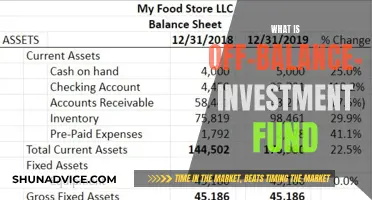
Mutual funds are a popular investment vehicle, especially for retirement accounts like 401(k)s. They are a relatively hands-off way to invest in multiple assets at once, providing instant diversification. Investing in mutual funds is attractive to those who don't want to pick individual investments but want to benefit from the stock market's high average annual returns. There are two main types of mutual funds: actively managed funds, which aim to beat the market but often come with higher fees, and passive funds, which aim to mimic the market and usually have lower fees. When investing in mutual funds, it's important to consider factors such as fund fees, investment budget, and brokerage options.
| Characteristics | Values |
|---|---|
| Investment type | Large-growth portfolios |
| Investment focus | Big U.S. companies with high growth rates and high valuations |
| Investment objective | Long-term capital growth |
| Total assets | $21.91 billion |
| Investment strategy | Growth stock |
| Fund type | Mutual fund |
| Fund performance | 27.6% YTD, 22.7% over 5 years |
| Expense ratio | 0.48% |
| Initial investment | $100 |
What You'll Learn

Understand the different types of mutual funds
Mutual funds come in a variety of types and are categorized by the types of investments they hold and their investment objectives. Here is an overview of some of the different types of mutual funds:
Stock Mutual Funds
Stock mutual funds exclusively own stocks, giving them the potential for greater volatility and higher overall returns than other types of mutual funds. They are further divided into funds focused on growth stocks, value stocks, or a combination of the two. Growth funds, for example, focus on companies with solid earnings, sales, and cash flow growth and typically do not pay dividends. Value funds, on the other hand, invest in stocks that are considered undervalued, aiming for long-term appreciation.
Bond Mutual Funds
Bond mutual funds exclusively own bonds, making them generally less volatile than stock funds but also likely to deliver lower returns over time. There are different types of bond funds, such as government bond funds and corporate bond funds, each with varying levels of risk and return.
Money Market Mutual Funds
These funds invest in safe, short-term debt instruments and cash equivalents, such as US Treasury bills and certificates of deposit (CDs). They are considered lower-risk investments but tend to offer lower returns than stocks or bonds. While these funds are generally safe, it is important to note that they are not insured by the Federal Deposit Insurance Corporation (FDIC).
Balanced Mutual Funds (or Asset Allocation Funds)
Balanced mutual funds invest in a mix of stocks, bonds, and money market instruments to provide diversification and lower volatility. The allocation of assets depends on the fund's investment manager and its expectations for return.
Target-Date Mutual Funds
Target-date funds are commonly used in retirement accounts, gradually shifting investments from higher-risk stocks to lower-risk bonds over time. They are designed for investors with specific retirement dates in mind, and the mix of assets changes according to the fund's strategy as the target date approaches.
Commodity Mutual Funds
Commodity mutual funds invest in companies involved in commodity-intensive industries such as energy exploration and mining. These funds can provide a hedge against inflation but tend to be more volatile than stock funds.
Environmental, Social and Governance (ESG) Funds
ESG funds consider non-economic factors when selecting investments, such as environmental responsibility, human rights, or religious views. These funds may also avoid investing in certain industries, such as defence, alcohol, tobacco, or gambling.
Active vs. Passive Mutual Funds
Active funds aim to outperform market benchmarks by selecting specific investments through analysis and research. Passive funds, on the other hand, aim to replicate the performance of a specific index, such as the S&P 500, and are often called index funds. Active funds tend to have higher fees due to the active management involved, while passive funds offer lower fees and are designed to minimize costs.
Investment Banking vs. Hedge Funds: Why Choose Banks?
You may want to see also

Research fees and sales charges
When investing in growth mutual funds, it is important to carefully consider the fees and sales charges associated with the funds. Mutual funds can come with various fees, and understanding these fees can help you make informed investment decisions. Here are some key aspects to consider:
- Expense Ratio: This is an ongoing fee charged by the fund company to cover the costs of managing the fund. It is expressed as a percentage of your total investment in the fund. For example, a 1% expense ratio means you pay $10 for every $1,000 invested. This fee is usually deducted seamlessly from your investment and can eat into your returns over time. It is important to carefully review the fund's prospectus to understand the expense ratio before investing.
- Sales Load or Commission: Some mutual funds charge a sales load or commission, which is paid to the broker or salesperson who sold the fund. This fee is typically passed on to the investor and can impact your returns. It is advisable to choose no-load funds or no-transaction-fee funds, which do not incur these additional costs.
- Early Redemption Fee: Some funds may charge an early redemption fee if you sell the fund before a minimum holding period, such as one month. It is important to consider this fee if you plan to trade the fund frequently.
- Transaction Fees: These fees are charged by the brokerage firm when you buy or sell mutual fund shares. They can vary depending on the brokerage firm and the specific fund. It is essential to consider these fees when deciding where to purchase your mutual funds.
- Management Fees: Active mutual funds, which are managed by professionals who actively select investments, typically have higher management fees than passive funds. These fees cover the cost of research, analysis, and portfolio management. Passive funds, such as index funds, generally have lower management fees since they aim to mimic a specific market index.
- Other Fees: Mutual funds may also have other fees, such as account fees, transfer fees, or distribution fees. It is important to carefully review the fund's prospectus or offering document to understand all the fees associated with the investment.
When investing in growth mutual funds, it is crucial to consider the impact of fees on your overall returns. Higher fees can reduce your net returns, so it is generally advisable to choose funds with lower expense ratios and no sales loads. Additionally, some funds may have performance fees, where a percentage of the profits are paid as a fee if the fund outperforms a specific benchmark. It is important to carefully review the fee structure of any fund before investing to ensure you understand all the costs involved. Remember, fees are an important consideration but should not be the sole factor in your investment decision. Other factors, such as the fund's investment strategy, performance, and risk profile, should also be evaluated to make a well-informed investment decision.
Mutual Funds: Where Are Your Investments Going?
You may want to see also

Learn how to pick the best funds for your portfolio
When it comes to choosing the best mutual funds for your portfolio, there are several key factors to consider. Here are some essential tips to help you make informed decisions:
- Define your investment goals and risk tolerance: Before investing, clearly understand your financial objectives and the level of risk you are comfortable with. Ask yourself whether you want steady growth with low risk or higher potential returns. Your risk tolerance will guide the types of mutual funds you choose.
- Understand management styles: Mutual funds can be actively or passively managed. Actively managed funds have portfolio managers who actively research and select investments, aiming to beat a benchmark index. These funds often come with higher fees. On the other hand, passively managed funds, or index funds, aim to replicate the performance of a specific market index and generally have lower fees.
- Know the different types of funds: Familiarize yourself with the various types of mutual funds, such as large-cap, small-cap, value funds, and growth funds. Each type specializes in different segments of the market and carries different levels of risk and potential returns.
- Be mindful of fees: Fees can significantly impact your investment returns. Look out for front-end and back-end load fees, as well as expense ratios. Compare fees across different funds to find the most cost-effective options.
- Research and evaluate past performance: Assess the quality of the fund by considering factors such as the fund's management team, historical performance, and turnover rate. A strong management team with a proven track record can add value. Additionally, evaluate the fund's performance over a reasonable time frame to ensure it has delivered consistent returns.
- Diversify your portfolio: Diversification is key to long-term success and stability. Consider investing in a variety of asset classes, such as stocks, bonds, international funds, real estate, and fixed-income funds, to reduce risk and enhance portfolio performance.
- Focus on long-term growth: Remember that past performance does not guarantee future results. Conduct thorough research and consult a financial advisor if needed. By selecting funds with strong historical performance and experienced fund managers, you can maximize your chances of achieving long-term portfolio growth.
Bear Market Strategies: Investing in Funds for Long-Term Growth
You may want to see also

Know the pros and cons of mutual funds
Mutual funds are a popular investment option. They allow investors to access a wide range of securities and help mitigate risk through diversification. However, like any investment, mutual funds have their own set of advantages and drawbacks. Here are some of the pros and cons to help you decide if they align with your financial goals and investment style.
Pros of Mutual Funds
- Diversification: Mutual funds typically invest in a diverse range of stocks and bonds, reducing investment risk. If certain fund assets lose value, gains in other areas can offset those losses.
- Professional Management: Mutual funds are actively or passively managed. Actively managed funds use active trading strategies to beat the market and may result in competitive returns. Passively managed funds track a stock market index and are recommended for long-term investing due to their lower costs.
- Convenience: Mutual funds offer a convenient way to invest in a diverse range of securities through a single investment.
- Compound Interest: Mutual funds allow investors to reinvest dividends, enabling compound growth over time.
Cons of Mutual Funds
- Fees and Charges: Mutual funds often come with high fees and sales charges, including load fees, operating expense ratios, and 12b-1 fees. These fees can eat into your investment returns.
- Tax Inefficiency: Taxes on capital gains distributions and dividends can make mutual funds less tax-efficient.
- Limited Control: Some investors prefer to be actively involved in trades and investment decisions. With mutual funds, a fund manager makes these decisions, which may feel too restrictive for self-directed investors.
- Minimum Investment: Mutual funds often require a minimum initial investment, which can range from $500 to $3,000, making them less accessible to some investors.
- Market Risk: Like any investment in stocks and bonds, mutual funds carry market risk. Investors can lose principal value during market downturns.
Index Funds: Where to Start Your Investment Journey
You may want to see also

Understand how to manage your portfolio
Understanding how to manage your portfolio is a key part of investing in growth mutual funds. Here are some detailed and direct instructions on how to do this:
Firstly, it's important to know that mutual funds are an excellent way to gain exposure to a variety of stocks, bonds, or other investments. They are a relatively hands-off investment, making them a popular choice for those who don't want to pick individual investments but still want to benefit from the stock market's high average returns.
When it comes to managing your portfolio, there are a few key steps to follow. Firstly, decide on your investing budget. Mutual funds usually have a minimum investment amount, which can range from $100 to a few thousand dollars. Once you meet this minimum, you can often choose how much to invest. It's important to invest an amount you're comfortable with and that fits your financial situation.
Next, consider your mix of funds. This will depend on your age and risk tolerance. Generally, the closer you are to retirement, the more conservative your investments should be. One option to consider is target-date funds, which automatically adjust your asset allocation as you age, reducing risk over time.
Once you've invested in mutual funds, it's important to regularly rebalance your portfolio to keep it in line with your diversification plan. For example, if one part of your portfolio has performed extremely well and now makes up a larger proportion than intended, you may want to sell some of those gains and invest in other areas to regain balance.
It's also crucial to stick to your investment plan and not chase performance. It can be tempting to invest in a fund after seeing its impressive returns from the previous year, but past performance doesn't guarantee future results. Instead, look for funds with consistent returns over a longer time horizon, such as three, five, or ten years.
Finally, remember that different types of mutual funds will bring different expectations for returns. Stock mutual funds have the potential for higher returns but also come with higher risks. Bond mutual funds provide more stable returns but with lower potential gains. Money market mutual funds are considered one of the safest investments, offering potential returns of 1% to 5% annually.
By following these steps and staying informed about your investments, you can effectively manage your portfolio and work towards your financial goals.
BlackRock Funds: A Guide to Investing in Their Success
You may want to see also
Frequently asked questions
Growth mutual funds are a type of investment fund that focuses on investing in companies with strong growth potential, typically in rapidly expanding industries. The goal is to achieve long-term capital growth by investing in stocks with high growth rates for earnings, sales, and cash flow.
When choosing a growth mutual fund, consider factors such as the fund's long-term track record, fees and expense ratios, investment strategy (active vs passive), and the types of companies it invests in (large-cap, small-cap, etc.). Diversification, risk tolerance, and time horizon should also be considered.
Growth mutual funds offer instant diversification, professional portfolio management, and the potential for high returns. They are also relatively hands-off, making them a popular choice for investors who don't want to actively pick and choose individual investments.
As with any investment, there are risks involved. Growth mutual funds may carry high fees and sales charges, and there is no guarantee that the fund will outperform the market. The value of the fund may fluctuate, and there is a potential for loss if the companies invested in do not perform as expected.







